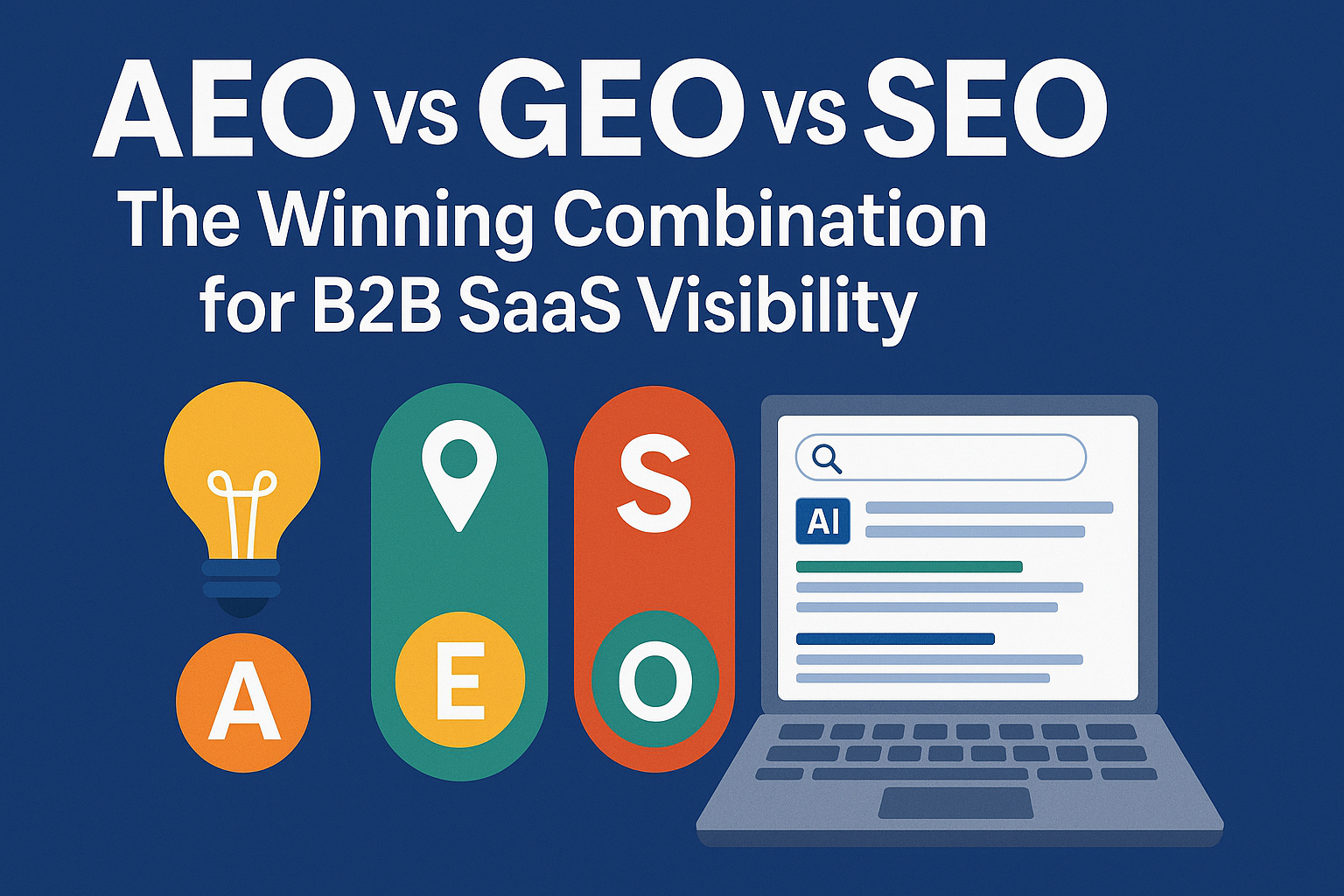B2B SaaS marketers have spent years refining SEO tactics targeting high-value keywords, building authoritative backlinks, and perfecting on-page optimization. But the rise of AI-driven search experiences like Google’s AI Overviews and conversational tools such as ChatGPT, Perplexity, and Gemini has transformed how prospects engage with information.
In fact, according to a recent HubSpot report, nearly 50% of decision-makers now interact with AI-generated answers before visiting a brand’s website.
For SaaS brands targeting legal, compliance, IT, or procurement buyers, traditional SEO alone no longer guarantees visibility. Prospects are increasingly bypassing standard search results in favor of AI-generated summaries, answer boxes, and conversational recommendations.
This shift demands a new content approach one structured to feed AI systems with clear, reliable, and machine-readable information. Done right, Answer Engine Optimization (AEO) can become the new front door to your SaaS buyer journey.
In this expanded guide, you’ll learn how to structure your content for AEO to increase visibility, earn featured snippets, and become the trusted source in AI-driven search experiences.
Why AEO Matters for B2B SaaS Brands
B2B SaaS buyers especially in compliance-driven industries prioritize research, clarity, and trusted recommendations. AI-powered search tools cater to that by summarizing key information from across the web. Without AEO, your brand risks becoming invisible during critical research moments.
Key Pain Points Driving the Shift:
- Buyers overwhelmed by fragmented information sources
- AI Overviews replacing traditional top-ranking organic links
- Reduced control over brand messaging in AI-driven search results
- Complex SaaS offerings require accurate, concise explanations
Stat to Consider: Gartner predicts that by 2026, 30% of web traffic will originate from AI-powered search tools and conversational interfaces.
Structuring for AEO ensures your content answers buyer questions directly, increases AI citation likelihood, and positions your brand early in the research journey.
What is Answer Engine Optimization (AEO)?
AEO is the process of preparing your content to rank within AI-generated responses, featured snippets, knowledge panels, and conversational search tools.
It expands on traditional SEO by emphasizing:
- Clear, direct answers to buyer questions
- Organized formats (lists, tables, definitions)
- Contextual authority signals (expert authorship, trusted sources)
- Schema markup and structured data for machine readability
AEO doesn’t replace SEO, it builds on it by helping your content show up in the places where AI tools pull answers, summaries, and recommendations.
Example: Google’s AI Overviews often extract responses from well-structured FAQs or summarized blog content. If your content lacks this structure, AI tools may bypass your brand entirely.
The New SaaS Buyer Journey: AI as the First Touchpoint
SaaS buyers researching contract management, compliance automation, or policy management software increasingly encounter AI-generated answers before landing on vendor websites.
Modern Buyer Journey Includes:
- Conversational queries on AI tools like ChatGPT or Perplexity
- AI Overviews summarizing solutions and providers on Google
- Featured snippets answering technical or operational questions
- Fewer direct website visits unless AI systems cite your content
SaaS marketers must proactively structure content to become the cited source in these AI-powered experiences.
Structuring Content for AEO: Tactical Steps for SaaS Marketers
To align your content with AEO standards, follow these actionable steps:
Lead with Direct, Concise Answers
Every high-performing AEO-optimized page starts by answering the core question within the first few lines. Whether it’s a product landing page, a blog, or a help center article, readers should immediately find a clear, simple response to the question they are searching for. For example, if your SaaS product focuses on AI sales software, the opening line should explain the solution in plain language: “AI sales software helps revenue teams prioritize leads, forecast sales performance, and automate outreach tasks using real-time data.” This approach not only helps buyers quickly understand your offering but also improves your chances of being cited in search summaries or AI-generated responses.
Use Organized Lists and Tables
Presenting complex information in a structured format makes your content easier to consume for both readers and search engines. Breaking down features, comparisons, or multi-step processes into numbered lists or tables enhances clarity and engagement. SaaS buyers researching technical products often look for side-by-side comparisons or clear overviews that help simplify decision-making. Structured formats, such as lists or tables, increase your likelihood of earning featured snippets or being highlighted in AI Overviews.
Implement Schema Markup
Schema markup is a powerful yet underused tool for improving content visibility in AI-driven search experiences. Adding structured data like FAQ schema, How To schema, or Product schema helps search engines categorize your content accurately. For example, if you’re publishing an FAQ page, integrating FAQ schema ensures your answers have a higher chance of appearing directly in Google search results or AI summaries. Schema acts as a signal to search engines that your content is well-structured and reliable.
Add TL;DR Sections
Including a TL;DR (Too Long; Didn’t Read) summary near the beginning of your content provides a quick reference point for busy decision-makers. It allows readers to understand the core message of your page in just a few seconds. For AI-driven platforms summarizing content, a TL;DR serves as a prime candidate for extraction. SaaS decision-makers often skim content, so a well-placed TL;DR boosts both user experience and your chances of being included in AI-generated search results.
Establish Author and Source Credibility
In competitive B2B markets, content credibility directly influences buyer trust. To strengthen your authority, always feature named authors with relevant expertise, especially for content covering technical, compliance, or regulatory topics. Including author bios, professional credentials, or real-world experience enhances trust and signals to search engines that your content is backed by subject matter expertise. Supporting your claims with reputable sources, verifiable statistics, and industry standards further increases the likelihood of your content being seen as reliable and authoritative.
Optimize for Conversational Search
B2B buyers now search using full questions and natural phrasing. Align your content with this behavior by using question-based headings and direct, jargon-free answers. For instance, instead of targeting just “AI sales software,” use headings like:
“What does AI sales software do for revenue teams?”
“How can AI tools improve sales forecasting accuracy?”
Structuring your content this way improves visibility in voice searches, AI-generated summaries, and chat-based interfaces, while addressing buyer intent more directly.
AEO Content Examples for B2B SaaS Brands
Practical applications of AEO across your SaaS content library:
Product Landing Pages
- TL;DR summary explaining product benefits
- Bullet-point feature lists aligned with buyer pain points
- Schema markup for product details (e.g., Product, Review schemas)
Educational Blog Posts
- Direct question-and-answer introductions
- Numbered lists explaining workflows or features
- Author bios, citations, and data-backed statements
FAQ and Resource Hubs
- Structured FAQ schema implementation
- Clear, concise answers to common buyer queries
- Internal links to related product or educational pages
Comparison or Competitor Pages
- Tables outlining feature differences
- Neutral, fact-based positioning to increase AI citation potential
- Schema markup for product and review data
Optimizing Existing Content for AEO: Step-by-Step Process
No need to reinvent your content library. Follow this process to retrofit for AEO:
- Audit content lacking summaries, structured answers, or clear formats.
- Reformat long paragraphs into lists, tables, or TL;DR sections.
- Implement missing schema markup, especially FAQs and HowTos.
- Enhance credibility with expert author bios and trustworthy citations.
- Test conversational phrasing to align with buyer search behavior.
Common AEO Mistakes to Avoid
Many marketers unintentionally limit AEO effectiveness by:
- Focusing solely on keywords without answering intent-driven questions
- Using lengthy intros that bury core answers
- Neglecting technical SEO elements like schema markup
- Overproducing generic, AI-written content lacking authority signals
Balancing technical structure with clarity and expertise is essential.
AEO as a Growth Engine for SaaS Brands
The AI evolution is fundamentally reshaping how buyers discover, evaluate, and select SaaS solutions. Answer Engine Optimization positions your brand to remain visible, trusted, and influential throughout that journey.
By structuring content for clarity, machine readability, and buyer trust, SaaS marketers can transform AI-driven search into a high-performing acquisition channel.
The buyer journey’s front door has changed your content must be ready to open it.

vetrivel is an accomplished SEO and digital marketing expert with 5 plus years of experience. dedicated to providing readers with informative and engaging content.




